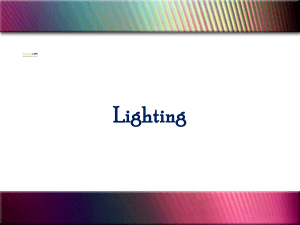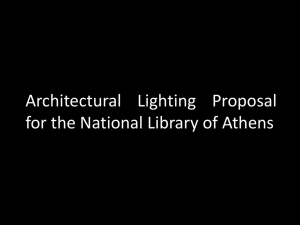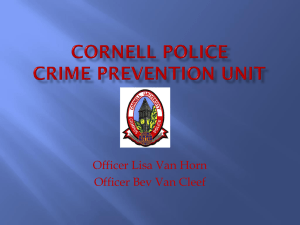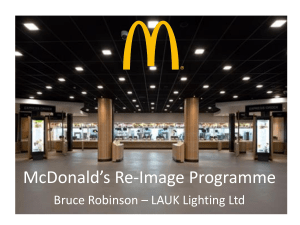Lecture 7
advertisement
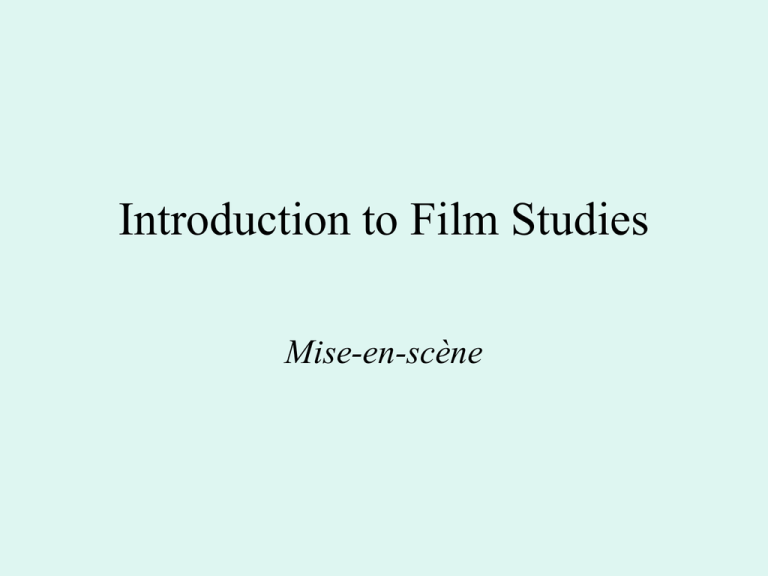
Introduction to Film Studies Mise-en-scène Make-up • No make-up applied on the face of Renée Jeanne Falconetti, a stage and film actress in The Passion of Jean of Arc • Hollywood stars are requested to get their teeth capped, eyebrows plucked and make-up applied. Erich von Stroheim – the first director to have made the actor to wear no make-up. White Queen (Anne Hathaway) in Tim Burton’s Alice in the Wonderland (2010) with many layers of foundation and powder finished with pink blusher. Elizabeth Taylor plays Cleopatra with plenty of green and blue eye shadow. Joseph Mankiewicz’s Cleopatra (1963) Daryl Hannah’s panda eyes in Ridley Scott’s Blade Runner (1982) Make-up • Monster is created by applying heavy make-ups • According to Mary Shelley’s Frankenstein, he has ‘watery glowing eyes’ and ‘flowing black lips’ • Definitive visualization of Frankenstein (1931) with flat head and hollow eyes. Girl at pond Make-up • One of the greatest make-up that has ever been applied in film. David Lynch’s Elephant Man (1980) John Hurt played Joseph Merrick and his make-up was based on a real-life cast made of Merrick’s head after his death. Train station Make-up • Whenever disguise takes place, make-up is the most significant way to do so. • Jack Lemon and Tony Curtis disguise as female musicians in Billy Wilder’s Some Like It Hot (1959) station Make-up • In The Curious Case of Benjamin Button (2008) Brad Pit is born as an old man and dies as a baby. The curious narrative requires different make-ups are applied to Pit’s face. Make-up • The heavily painting make-up in The Cabinet of Dr. Caligari fits not only the characterization in the narrative but also the other aspects of mise-enscène: lighting and expressionistic set design Lighting • Lighting – more than just illumination • Lighter and darker areas create an overall composition of each shot • They guide attention to certain objects and actions • A bright patch draw our eye to a key gesture • A shadow conceal a detail or build up suspense • Lighting articulate textures Standard three point lighting: key, fill and back lighting Key lighting Fill lighting 3 point lighting Lighting • Highlight – a patch of relative brightness on a surface • Part of a woman’s face in Matter of Life and Death and metal grills in 400 Blows display highlights • Highlight shows the texture – the woman’s soft Lighting • Shadows • An ‘attached’ shadow occurs when light fails to illuminate part of an object, because of its shape or its surface feature • Patches of a girl’s face and body falls into darkness in Spirit of Beehive Frankenstein Lighting • A ‘cast’ shadow occurs when a source of light projects shadows because something in front of it blocks out the light • Kurosawa Akira’s The Stray Dog, cast shadows of bars between the actors and the light source. Lighting • Lighting shapes a shot’s overall composition • A pool of light cast by a hanging lamp sets up a scale of importance. The man the most clearly lit is the prominent gangster in Asphalt Jungle. Lighting • ‘The proper use of light can embellish and dramatize every object.’ Joseph von Sternberg • 4 major features of film lighting • QUALITY; DIRECTION; SOURCE; COLOUR • QUALITY - The relative intensity of the illumination • Hard lighting (noon day, summer sunlight) – strong shadow • Soft lighting (overcast, winter day) – defused illumination and soft shadows Lighting • Hard lighting – bold shadows and crisp textures and edges • Soft lighting – blurs contours and texture and make more diffusions and gentler contrasts between light and shade Satyajit Ray’s Aparajito (1956) Lighting • The hard light can be created by a concentrated source and creates harsh, sharp-edge shadows. It renders the image heavy and serious look. • Wong Kar Wai’s In the Mood for Love (2000) photographed by Christopher Doyle. Relatively small light source results in a sharp boundary between the lit and shaded side of the object. Lighting • Akira Kurosawa made hard lighting even harder by using mirrors. Mirrors reflect harsh light. Photographer, Kazuo Miyagawa. Tajomaru Lighting • Soft light occurs when a light source is large relative to and farther from the subject, and cast diffused shadows with soft edges. It renders images lyrical and happy feel. • Lasse Hallström’s Dear John (2010) photographed by Terry Stacey, love-romance/war film. Relatively large light source results in a blurred boundary between the lit and shaded side of the object. Romantic comedy use soft lighting to fit the mood: diffused and soft edge shadows In Film noir - post-war crime cinema, hard lighting is the essential part of its visual style. Dark and tragic film ending with the self-destruction. Lighting • DIRECTION • The path of light from its source(s) to the object lit • Frontal lighting tends to eliminate shadows • Frontal lighting results in a fairly flat-looking image • Jean-Luc Godard’s La Chinoise (1967) Lighting • The source of illumination is placed near the camera. Paul Thomas Anderson’s Magnolia (1999) photographed by Robert Eslwit Lighting • Hard Side lighting sculpts the character’s features and the object’s contour. • The right half of the man’s face is in complete shadow, Carol Reed’s The Man between (1953) Side lighting gives the image dramatic feel. Francis Ford Coppola’s Godfather (1972) photographed by Gordon Willis. Lighting • Back lighting comes from behind the subject filmed. It can be positioned at many angles and tends to create silhouettes • Carol Reed’s The Third Man (1949) photographed by Robert Krasker Back lighting gives the images mysterious or menacing atmosphere. Ridley Scott’s Blade Runner (1982) photographed by Jordan Croneweh. Back lighting gives the contours of the subject glow. Final Battle In James McTeigue’s V for Vendetta, the most of V’s body is concealed and when it is shown, strong backlights are used with a less powerful light showing his face. Lighting • In under lighting the light comes from below the subject filmed. In Tim Burton’s first Batman, the low angle shot is combined with under lighting. • It creates distorted images. Joker Jack Nicholson again shown in under lighting. It is frequently used in horror films. Stanley Kubrick’s Shining Lighting • In top lighting the spotlight shines down from above. Marlene Dietrich’s face is lit from top front in Josef von Sternberg’s Shanghai Express (1932). A high frontal light brings out the line of her cheekbones and create shadows in her eye sockets. Hint of corruption and mysterious sexuality. SX Lighting • In Colour lighting, thin colour film placed in front of a light gives image a universal tint. Lighting • In Michael Powell and Emeric Pressburger’s Black Narcissus, their cinematographer Jack Cardiff got scenes lit in bold colours. Lighting • The theatrical lighting in blue in the concluding sequence of Nagisa Oshima’s last film, Taboo (1999) Lighting • In William Wyler’s Jezebel, Bettie Davis is a central figure and lit by the key light from top right, by the fill light from left and by the back light from slightly high at back. The figures in front remain rather dark as the light do not reach them. Lighting • Three point lighting in a colour film • Strong key light from left, a fill light from off right of the camera, and the office behind the couple is lit more dimly and softly with background light. • Whenever the camera position moves, the lighting positions must be rearranged. Lighting • Three point lighting suited to high-key lighting • Photography with low contrast between brighter and darker areas • The most frequently used in classical Hollywood cinema. Lighting • Low-key lighting creates stronger contrasts and sharper, darker shadows. The lighting is hard, and fill light is lessened or switched off. • Light is hard and comes from right in the shot above, The Maltese Falcon. Fill and back light eliminated creating a dark shadow on the wall Lighting • The fill light and back light are significantly less intense in Andrzey Wajda’s Kanal making the back of the screen remain opaque. Lighting • Low-key lighting has usually been applied to somber or mysterious scenes. Common in horror films of the 30s and film noir in the 40s and 50s. Revived in the 80s in such films as Blade Runner and Rumble Fish






